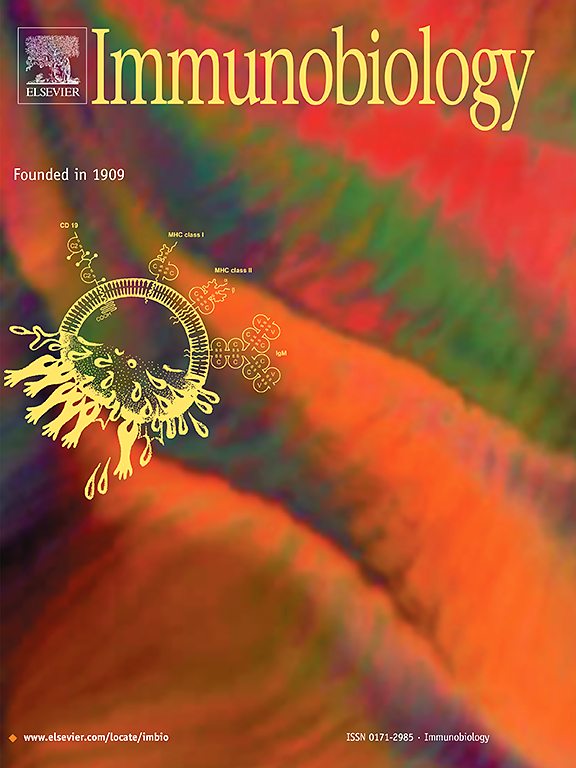基于三级淋巴结构的病理评分预测结直肠癌患者的生存和复发
IF 2.3
4区 医学
Q3 IMMUNOLOGY
引用次数: 0
摘要
背景,结直肠癌(CRC)是一个主要的全球健康负担。肿瘤微环境(TME)内的免疫反应,特别是三级淋巴结构(TLS)的存在,在预后中起着至关重要的作用。然而,目前的预后工具往往忽略了这种免疫成分。本研究旨在表征CRC中的TLS,并开发与生存结果相关的TLS评分。方法回顾性分析来自Finistere消化道肿瘤登记处的806例结直肠癌患者的7895个TLS。采用苏木精-伊红-藏红花(HES)染色和免疫组化(IHC)对TLS进行定量分析,探讨其与生存和复发指标的关系。结果微卫星不稳定(MSI)患者的TLS密度更高,TLS成熟度更高。TLS密度和成熟度与总生存期(OS)和无病生存期(DFS)均有显著相关性。Kaplan-Meier分析显示,TLS密度和gc样成熟度的增加与OS和DFS的改善相关。我们的新病理TLS评分整合了密度和成熟度,有效地根据生存和复发风险对患者进行分层,区分预后较差的高危患者(评分0-1-2)和预后较好的低危患者(评分3-4)(p <;0.0001),特别是II-III期病例。结论tls密度和成熟度是结直肠癌的可靠预后指标。提出的TLS评分可以帮助病理学家识别复发风险较高、生存期较差的患者,指导临床决策监测和潜在的辅助治疗。在临床应用之前,进一步验证这些发现是必不可少的。本文章由计算机程序翻译,如有差异,请以英文原文为准。

A Tertiary lymphoid structures-based pathological score predicts survival and recurrence in colorectal Cancer patients
Background & Aim
Colorectal cancer (CRC) is a major global health burden. The immune response within the tumor microenvironment (TME), especially the presence of tertiary lymphoid structures (TLS), plays a critical role in prognosis. However, current prognostic tools often overlook this immune component. This study aimed to characterize TLS in CRC and develop a TLS-score correlating with survival outcomes.
Methods
We conducted a retrospective analysis of 7895 TLS from 806 CRC patients using data from the Finistere Registry of Digestive Tumors. Hematoxylin-eosin-saffron (HES) staining and immunohistochemistry (IHC) were employed for TLS quantification to explore their relationship with survival and recurrence metrics.
Results
Patients with microsatellite instability (MSI) demonstrated higher TLS density and more mature TLS. Both TLS density and maturation showed significant correlations with overall survival (OS) and disease-free survival (DFS). Kaplan-Meier analysis revealed that increased TLS density and GC-like maturation correlated with improved OS and DFS. Our novel pathological TLS score, integrating density and maturation, effectively stratified patients by survival and recurrence risk, distinguishing high-risk individuals (score 0–1–2) with poorer outcomes from low-risk patients (score 3–4) with better prognosis (p < 0.0001), particularly in stage II–III cases.
Conclusion
TLS density and maturation are robust prognostic markers in CRC. The proposed TLS score may aid pathologists in identifying patients at higher recurrence risk and poorer survival, guiding clinical decisions for monitoring and potential adjuvant therapies. Further validation of these findings is essential before clinical implementation.
求助全文
通过发布文献求助,成功后即可免费获取论文全文。
去求助
来源期刊

Immunobiology
医学-免疫学
CiteScore
5.00
自引率
3.60%
发文量
108
审稿时长
55 days
期刊介绍:
Immunobiology is a peer-reviewed journal that publishes highly innovative research approaches for a wide range of immunological subjects, including
• Innate Immunity,
• Adaptive Immunity,
• Complement Biology,
• Macrophage and Dendritic Cell Biology,
• Parasite Immunology,
• Tumour Immunology,
• Clinical Immunology,
• Immunogenetics,
• Immunotherapy and
• Immunopathology of infectious, allergic and autoimmune disease.
 求助内容:
求助内容: 应助结果提醒方式:
应助结果提醒方式:


